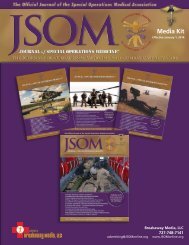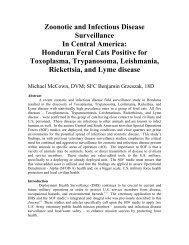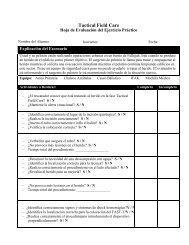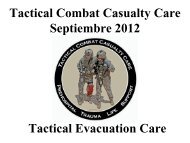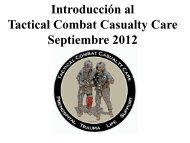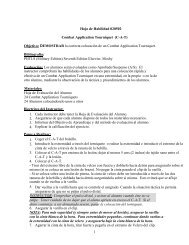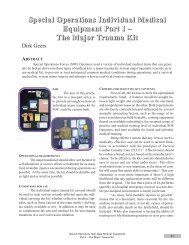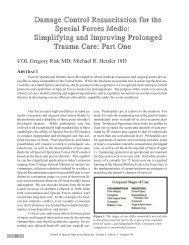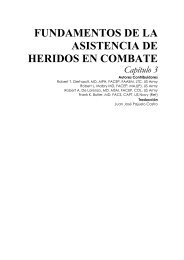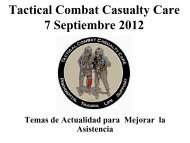Geers D. Special Operations Individual Medical Equipment Part 2
Geers D. Special Operations Individual Medical Equipment Part 2
Geers D. Special Operations Individual Medical Equipment Part 2
You also want an ePaper? Increase the reach of your titles
YUMPU automatically turns print PDFs into web optimized ePapers that Google loves.
<strong>Special</strong> <strong>Operations</strong> <strong>Individual</strong> <strong>Medical</strong><br />
<strong>Equipment</strong> <strong>Part</strong> 2 –<br />
The In-Use and Survival <strong>Medical</strong> Kits<br />
Dirk <strong>Geers</strong><br />
ABSTRACT<br />
<strong>Special</strong> <strong>Operations</strong> Forces (SOF) Operators need a variety of individual medical items that can generally<br />
be broken down into three types of medical kits: a major trauma kit, to treat major traumatic wounds; an in-use medical<br />
kit, to prevent or treat anticipated common medical conditions during operations; and a survival medical kit,<br />
to treat minor injuries and ailments when in a survival/evasion situation.<br />
AIM<br />
The aim of this article, the second in a two-part<br />
series, is to provide insight on how to custom-build an<br />
individual in-use medical kit and survival medical kit<br />
for SOF.<br />
OPERATIONAL REQUIREMENTS<br />
An in-use medical kit allows SOF Operators to<br />
prevent or treat injuries and ailments likely to occur and<br />
require immediate attention, or to prevent potential<br />
mission-degrading medical conditions on a routine<br />
basis. A survival medical kit should allow a SOF Operator<br />
in a survival/evasion situation to treat a reasonable<br />
range of anticipated injuries and ailments in order<br />
to allow him the ability to evade back to friendly positions<br />
or await recovery. These kits should be small,<br />
durable and light.<br />
CONDITIONS FOR USE<br />
The kit allows a SOF Operator to provide basic<br />
self-care without having to rely on the team medical<br />
pack or when no collective medical supplies are available,<br />
i.e. when a team is split to conduct a short-duration<br />
task without a medic.<br />
Contents from a survival medical kit should<br />
only be used when in a survival/evasion situation, i.e.<br />
when an SOF Operator is definitively separated from<br />
his team, if evading with others, or when cut-off from<br />
any collective medical supplies, such as those carried in<br />
the team medic’s medical pack.<br />
CRITERIA FOR SELECTING KIT CONTENTS<br />
The kits should meet the operational requirements<br />
listed above. A balance should be sought between<br />
light weight and compactness on the one hand,<br />
and comprehensiveness on the other. A sensible approach<br />
is to limit kit contents to items most likely to be<br />
needed and those of greatest importance.<br />
During mission execution or when evading,<br />
SOF personnel may find themselves in remote areas,<br />
encountering environmental hazards similar to those<br />
faced by wilderness travelers. 1 Based on this assumption,<br />
identifying the most common medical problems<br />
encountered during wilderness travel will help to select<br />
kit contents, realizing that tactical considerations should<br />
be taken into consideration. Invaluable additional information<br />
may be available from classified sources,<br />
such as survival, evasion, resistance, and escape<br />
(SERE) products.<br />
Various common medical problems have been<br />
reported during outdoor activities, including foot blisters,<br />
gastrointestinal disorders, cuts, abrasions, bites,<br />
stings, infections of the skin and upper respiratory tract,<br />
musculoskeletal injuries, and pain/aches. 2-12 Contents<br />
should reflect health threats specific to the theatre of<br />
operations, e.g. altitude and endemic diseases, as well as<br />
specific personal medical requirements, such as allergies.<br />
Temperature range and humidity are also important<br />
considerations, e.g. certain medical products do not<br />
remain stable in hot humid climates, although conclusive<br />
data is not readily available for most medications. 13<br />
Other factors dictating the kit’s contents are the<br />
individual’s level of medical proficiency and the availability<br />
of controlled medicines. As a survival medical<br />
kit is intended to be used by an isolated individual, this<br />
shouldn’t contain any items that cannot be used on oneself.<br />
POSSIBLE CONTENTS<br />
Taking into account the above criteria, possible<br />
contents are listed as follows:<br />
Wound cleansing items<br />
Wound cleansing materials have to be included<br />
in order to prevent wound infection. Several survival<br />
<strong>Special</strong> <strong>Operations</strong> <strong>Individual</strong> <strong>Medical</strong> <strong>Equipment</strong><br />
<strong>Part</strong> I – The Major Trauma Kit<br />
3
manuals recommend potassium permanganate to be included<br />
as an antiseptic, due to its potential use for other<br />
applications as well, 13-16 but its effectiveness is seriously<br />
questioned. 17 Even for more commonly used antiseptics<br />
such as povidone iodine and chlorhexidine, there<br />
seems to be no consensus as to their advantage to clean<br />
a contaminated wound. 18,19 Apart from their questionable<br />
effectiveness, there is some concern over the safety<br />
of antiseptics on open wounds, as they may be toxic to<br />
cells essential to wound healing, although this may be<br />
dependent on the concentration. 20,21<br />
Whereas data on the effectiveness of antiseptics<br />
remains inconclusive at best, it seems to be much more<br />
accepted that wound irrigation is an effective and preferred<br />
method for wound cleansing. 22-24 When using<br />
water to irrigate a wound, potable water seems to be adequate,<br />
if not better, than normal saline. 25-32<br />
Pressure required for irrigation is an important<br />
consideration; forcefully injecting the irrigant solution<br />
with a syringe through an 18 to 20 gage plastic catheter<br />
(without the needle) held about ½”-1” from the wound,<br />
generates sufficient pressure. 33-36 Low pressures generated<br />
by piston syringes without a catheter or by bulb sy-<br />
Figure 1: Irrigation<br />
syringe with dedicated<br />
and improvised<br />
18g tips<br />
ringes, are not adequate. 37,38 <strong>Special</strong>ly designed<br />
irrigation syringe tips are commercially available. (Figure<br />
1) One model integrates a shield to protect against<br />
splashes. While it works well, this protection is not required<br />
for self-aid,<br />
in addition, the device<br />
is bulky and<br />
being made of polystyrene,<br />
it is relatively<br />
fragile.<br />
A l t h o u g h<br />
the optimal volume<br />
required is unknown,<br />
39 at least<br />
100-300ml may<br />
have to be used<br />
until visible contamination<br />
is removed.<br />
40 These<br />
amounts of water fall within the limits of what can realistically<br />
be expected to be carried by dismounted individuals.<br />
Wound irrigation is probably as effective as<br />
cleaning a wound with gauze swabs, 41 which along with<br />
tweezers, may still be required if embedded particles<br />
cannot be removed by irrigation. 42<br />
Wound dressings and tape<br />
It is recommended that once a wound has been<br />
cleaned it should be covered with a dressing to prevent<br />
further contamination. Traditional wound dressing materials<br />
include non-adherent dressings (as an initial<br />
layer), gauze pads (to absorb wound exudate) (Figure<br />
2), and bandages, as well as adhesive tape or retention<br />
sheets, to keep the dressings in place and further protect<br />
wounds. For small wounds, combined adhesive dressings/bandages<br />
are more convenient.<br />
Protecting wounds<br />
from the environment with<br />
traditional dressings is not<br />
easy, and even when kept<br />
dry, they should be<br />
changed regularly. Moisture<br />
vapor permeable adhesive<br />
film dressings<br />
(consisting of a thin vaporpermeable<br />
polyurethane<br />
film sheet, coated with an<br />
adhesive) can be applied to<br />
superficial wounds with<br />
minimal exudate, and can<br />
also be used as a secondary<br />
dressing to keep other<br />
dressings in place. 43 (Figure<br />
3) Hydrocolloid dressings (which are thicker and contain<br />
gel-forming agents that absorb liquid and keep the<br />
wound hydrated) are better able to cope with wound exudate<br />
production. 44 (Figure 4) Both types are impermeable<br />
to micro-organisms and liquids and can remain in<br />
place for several days. Some are individually sealed in<br />
a waterproof package, some also have integral gauze<br />
pads (providing an all-in-one composite dressing), and<br />
some provide enhanced adhesion for use in hot and<br />
humid environments. These dressings should be large<br />
enough to adhere to the skin up to about an inch from the<br />
wound edges.<br />
Figure 4: Hydrocolloid dressings<br />
Figure 2:<br />
Non-stick<br />
dressing<br />
(left) and<br />
gauze pads<br />
(right)<br />
Figure 3: Adhesive film<br />
dressings<br />
While some wilderness medicine handbooks<br />
mention a requirement for primary dressings to be sterile,<br />
45,46 other manuals simply recommend clean dressings.<br />
47,48 The benefits of more expensive sterile over<br />
non-sterile dressings are far from clear. 49,50<br />
4<br />
Journal of <strong>Special</strong> <strong>Operations</strong> Medicine Volume 10, Edition 1 / Winter 10
Although<br />
specifically designed<br />
primary and<br />
secondary dressings<br />
exist to preventively<br />
mask<br />
friction-prone skin<br />
areas and/or to<br />
cover them following<br />
development of<br />
Figure 5: Blister dressings blisters, the aforementioned<br />
moisture<br />
vapor permeable adhesive film and hydrocolloid<br />
dressings can be used to prevent and treat blisters as well.<br />
(Figure 5) When selected to be used on feet, many have<br />
to be covered with tape to keep them in place and/or to<br />
protect them from friction.<br />
Tape can also be used on its own to prevent blisters.<br />
Sheets, such as self-adhesive, non-woven fabric<br />
dressing retention sheets, or tape rolls with a peel-off<br />
backing, are much more convenient than most rolls of tape<br />
where the tape sticks to itself, as the required amount and<br />
sizes can easily be cut and stored flat, thus usually taking<br />
significantly less space, while they can also easily be split<br />
over different kits or kit components. (Figure 6)<br />
For the<br />
surface closure<br />
of cuts, wound<br />
closure strips<br />
are useful, and<br />
often preferred<br />
to anything<br />
else. 51,52 They<br />
take up less<br />
space than specially<br />
designed<br />
Figure 6: Self-adhesive tape and dressing<br />
butterfly bandages,<br />
although<br />
retention sheets with peel-off backing<br />
both can be improvised using other types of adhesive tape.<br />
Skin adhesive<br />
In order to improve the adhesive power of tape,<br />
wound closure strips, and blister dressings, a skin adhesive<br />
may be required. Compound tincture of benzoin, or<br />
Friar’s balsam, is widely used, but may not always be able<br />
to sufficiently augment adhesion in wet environments. 53<br />
Preparations containing gum mastic reportedly provides<br />
better adhesive strength than those based on benzoin. 54,55<br />
(Figure 7)<br />
Skin cleaning fluid<br />
An alcohol-based skin cleaning fluid is useful to<br />
clean the skin before applying adhesives so they will stick<br />
better. Some types are claimed to also toughen the skin,<br />
which is useful as a blister prevention measure, 56 but firm<br />
data confirming this characteristic is lacking.<br />
Figure 7: Gum mastic (left)<br />
and compound tincture of<br />
benzoin (right) skin adhesives<br />
Foot powder<br />
Foot powder may help to prevent friction blister<br />
formation on feet. Many types are only of benefit for<br />
a short while and actually increase the occurrence of<br />
blister formation when used longer than one hour, while<br />
aluminum-containing antiperspirants may work better<br />
for long-duration use. 57 Foot powder is also useful<br />
when using tissue adhesives to reinforce blister dressings,<br />
where it can be sprinkled after applying the dressing,<br />
in order to neutralize any adhesive extending<br />
beyond the margins of the dressing, preventing socks<br />
from sticking to the skin or to the dressing 58 .<br />
Lubricants<br />
Lubricants are useful to prevent or alleviate the<br />
painful effects of chafing by clothing or equipment<br />
against the skin, which depending on the individual,<br />
typically occurs on the inner thighs when sweating<br />
heavily or when clothing gets wet from rain. Care<br />
should be taken when selecting a product that is intended<br />
primarily to be applied to the feet, as just like<br />
some foot powders, they may increase the incidence of<br />
blisters during long-duration activities. 59 Bottles with a<br />
roll-on applicator are often bulky and heavy and may<br />
easily leak their greasy contents. A semi-solid lubricant<br />
such as petroleum jelly (petrolatum, soft paraffin) is<br />
more convenient and can also be used to protect the lips<br />
from the wind, or to soothe cracked skin. Vaseline<br />
gauze can be used for treatment of injuries and can also<br />
serve as a candle when needed.<br />
Analgesics<br />
Different types of painkillers should be carried.<br />
An antipyretic analgesic provides relief for minor pain,<br />
and also reduces fever. Acetaminophen (called paracetamol<br />
in Europe) is the usual drug of choice. Acetylsalicylic<br />
acid (aspirin) is to be avoided, as it acts as a<br />
blood thinner (impeding blood clot formation in case of<br />
bleeding) and is more easily affected by heat and humidity.<br />
Anti-inflammatory analgesics provide relief for<br />
mild to moderate pain, and are useful for musculoskeletal<br />
pain such as sprains and bone injuries. Traditional<br />
non-steroidal anti-inflammatory analgesics, such<br />
<strong>Special</strong> <strong>Operations</strong> <strong>Individual</strong> <strong>Medical</strong> <strong>Equipment</strong><br />
<strong>Part</strong> 2 – The In-Use and Survival <strong>Medical</strong> Kits<br />
5
as ibuprofen, also interfere with the blood’s ability to<br />
clot and are better replaced by newer types such as<br />
meloxicam. For moderate to severe pain, a stronger<br />
analgesic may be added.<br />
Antidiarrheals<br />
As diarrhea is a very common outdoor problem,<br />
it is important to carry bowel motion inhibitors such as<br />
loperamide. While these only treat the symptoms of diarrhea<br />
and not the underlying cause, their usefulness lies<br />
in the fact that they limit the number of stools, an important<br />
consideration while on the move.<br />
Antiemetics<br />
Antiemetics are especially useful where there is<br />
a risk of dehydration, if vomiting interferes with fluid<br />
intake, or to prevent vomiting (as an anticipated sideeffect)<br />
prior to taking other medication such as some antimalarials.<br />
61<br />
Antitussives<br />
Coughs are a common symptom associated<br />
with respiratory infections that are rarely life-threatening<br />
and usually self-limiting. 62 While symptomatic<br />
treatment may not be medically necessary, tactical considerations<br />
may require antitussives to be carried.<br />
Codeine phosphate is commonly used as an antitussive.<br />
It can also be used as an analgesic (alone or in combination<br />
with acetaminophen, providing stronger analgesia<br />
than either acetaminophen or codeine alone), 63 or to<br />
treat diarrhea. 64,65<br />
Antibiotics<br />
Oral antibiotics to treat (bacterial) diarrhea are<br />
routinely recommended for travelers going to tropical/remote<br />
areas, 66, 67 and often antibiotics for skin infections<br />
and for respiratory infections are recommended<br />
as well. 68,69<br />
Once antibiotic treatment is started, it is important<br />
to take a full course, often continuing for at least a<br />
couple of days after the signs and symptoms of infection<br />
have disappeared. Depending on tablet/capsule size and<br />
the number of daily doses required, this means that antibiotics<br />
can take up considerable space, so ideally, a<br />
single broad-spectrum antibiotic should be selected.<br />
Quinolones such as ciprofloxacin or levofloxacin may<br />
be effective to treat all the aforementioned infections,<br />
but more than one antibiotic may be required in case of<br />
quinolone allergy. 70,71 An additional advantage of<br />
ciprofloxacin is its stability long after the manufacturer’s<br />
expiration date, even under hot and humid conditions.<br />
72 Although included in recommended personal<br />
medical kit lists of several wilderness medicine handbooks,<br />
73 topical eye antibiotics should not be generally<br />
included in individual medical kits, as using them for<br />
the wrong disorder might do more harm than good. 74<br />
Correct self-diagnosis of eye disorders by non-medical<br />
personnel is difficult in the field, and even if the knowledge<br />
was present, several diagnostic items would still<br />
be required. 75<br />
Antihistamines<br />
Antihistamines are useful for treating the symptoms<br />
of allergic reactions, especially after insect bites<br />
and stings. Although some survival manuals recommend<br />
antihistamine cream to be carried, 76 topical antihistamines<br />
can cause skin sensitization and may be less<br />
effective, 77 so it is better to select a long-lasting non-sedating<br />
oral antihistamine (e.g. cetirizine).<br />
Antimalarials<br />
Malaria is an infectious disease that occurs in<br />
those (sub)tropical areas in which Anopheles mosquitoes<br />
are present. Depending on the risk in the operational<br />
area (which may vary according to exact location,<br />
altitude, and season), antimalarials may have to be taken<br />
prophylactically, in addition to other measures, as no<br />
single preventive measure is 100% effective. The exact<br />
type depends on several factors, including the geographical<br />
area and individual tolerance, and will have to<br />
be tailored to each individual. 78 As acute severe falciparum<br />
malaria is a medical emergency, 79 antimalarials<br />
for emergency self-treatment should be carried as well.<br />
They may be different from the drugs to be taken prophylactically.<br />
Oral rehydration salts (ORS)<br />
ORS sachets contain a balanced mixture of dry<br />
salts and carbohydrates, used to treat dehydration and<br />
sodium and potassium depletion due to excessive perspiration<br />
or diarrhea. While glucose-based ORS help<br />
maintain hydration, ORS containing rice-based complex<br />
carbohydrates are a better choice, as they also decrease<br />
stool volume, shorten the duration of diarrhea, and more<br />
effectively promote water absorption. 80-83 (Figure 8)<br />
Figure 8:<br />
Glucose-based<br />
(left) & ricebased<br />
(right)<br />
oral rehydration<br />
salts<br />
6<br />
Journal of <strong>Special</strong> <strong>Operations</strong> Medicine Volume 10, Edition 1 / Winter 10
Insect repellent<br />
Besides being a nuisance, insects can transmit<br />
many diseases and their bites usually cause local<br />
swelling and itching, which in turn may lead to secondary<br />
skin infection due to scratching. The use of insect<br />
repellent is an essential part of personal protective<br />
measures to avoid insect bites, 84 although it does not<br />
protect against stinging insects, such as bees and<br />
wasps. 85 Repellents containing KBR 3023 or containing<br />
DEET (N,N-diethyl-3-methylbenzamide, previously<br />
called N,N-diethyl-m-toluamide) work well, but<br />
many products containing essential oils (e.g. citronella)<br />
as the active ingredient, are only effective for a short<br />
while at best. 86 Higher DEET concentrations provide<br />
longer-lasting protection, but the increase in duration is<br />
disproportional in concentrations above 50%. Extended-release<br />
DEET formulations can prolong the<br />
protection without increase in concentration. 87 As repellents<br />
are unable to protect skin more than 4cm away<br />
from the application site, 88 correct application implies<br />
covering all areas of exposed intact skin, while ensuring<br />
they don’t come into contact with the mouth, the<br />
eyes, open wounds, irritated skin, and in the case of<br />
DEET, also plastic spectacles or watches. Repellents<br />
are affected by environmental effects such as exposure<br />
to heat and humidity, so a large enough supply should<br />
be carried so it can be reapplied regularly.<br />
Water disinfection tablets<br />
While cooking might be the best option to kill<br />
harmful micro-organisms in water, this is often not possible<br />
in an evasion scenario, so water disinfection<br />
tablets should be carried. If a water filtration system is<br />
carried, additional treatment with chemicals will almost<br />
always be required anyway, since most filters<br />
alone cannot reliably remove viruses. Large-capacity<br />
individual systems that provide adequate disinfection<br />
are usually too bulky to be routinely carried on the<br />
body, Disinfection tablets provide a useful alternative<br />
in an evasion scenario, for almost no space/weight<br />
penalty.<br />
Chlorine or iodine tablets are a traditional<br />
choice, but although effective against bacteria, viruses,<br />
and most protozoa, including highly resistant giardia<br />
lamblia cysts, 8,9,90 they are not effective at practical<br />
doses and contact times against omnipresent and diarrhea-causing<br />
cryptosporidium oocysts. 91,92 In addition,<br />
when using chlorine or iodine tablets, prior filtration<br />
to remove suspended particles will usually be required<br />
due to these disinfectants’ reaction with organic material,<br />
leaving a reduced concentration available for disinfecting<br />
the water being treated. Either a dedicated<br />
device (e.g. Millbank bag) or an improvised filter will<br />
then have to be used. Portable water filters with sufficiently<br />
small pore sizes can eliminate cryptosporidium<br />
cysts, but may rapidly become clogged, if used to filter<br />
debris. 93<br />
In spite of recommendations found in some<br />
survival manuals, potassium permanganate has no<br />
proven record of efficacy, while there are concerns<br />
over its toxicity. 94 Tablets containing silver ions as the<br />
only active ingredient are only effective against bacteria,<br />
95 not against viruses and protozoa, and are merely<br />
intended to protect stored drinking water against<br />
(re)contamination. However, most waterborne<br />
pathogens, including cryptosporidium, can be inactivated<br />
by chloride dioxide, 96,97 which can now be generated<br />
easily from relatively small tablets, providing a<br />
convenient water disinfection option in the field. If intelligence<br />
indicates that chemical pollution is present,<br />
a system integrating a carbon filter may be required.<br />
Dental cavity filling<br />
A temporary dental cavity filling is useful to<br />
treat toothaches caused by lost fillings or damaged<br />
teeth. 98,99 The basic materials used for temporary fillings<br />
are zinc oxide and oil of cloves (eugenol), which<br />
will have to be mixed. 100 A very small tube containing<br />
a single material which hardens after contact with humidity<br />
(saliva) takes less space and is easier to use than<br />
a multi-component mixture.<br />
Tweezers<br />
Tweezers with a fine point are very useful in<br />
many environments to remove ticks or embedded objects<br />
(e.g. thorns, wood splinters) from the skin. (Figure<br />
9)<br />
Bite/sting suction device<br />
In spite of manufacturers’ claims and previous<br />
recommendations to use a mechanical venom suction<br />
Figure 9: Tweezers<br />
device immediately following snakebite, 101 there seems<br />
to be no scientific proof that sufficient venom is removed<br />
to make any difference. 102 While it also hasn’t<br />
been proven that suction is harmful to humans, 103 there<br />
are some concerns that the concentration of venom<br />
under the suction cup may cause massive tissue necrosis.<br />
104 The lack of evidence that it really works, means<br />
that carrying this relatively bulky device should be<br />
considered only if it is felt that it may be of psychological<br />
benefit, realizing that other treatment options,<br />
which may be fairly limited when isolated, should not<br />
be delayed by its use.<br />
<strong>Special</strong> <strong>Operations</strong> <strong>Individual</strong> <strong>Medical</strong> <strong>Equipment</strong><br />
<strong>Part</strong> 2 – The In-Use and Survival <strong>Medical</strong> Kits<br />
7
High-altitude medication<br />
For high-altitude patrols, oral medications to<br />
deal with altitude-related illnesses should be carried by<br />
all patrol members. 105 Commonly used medications include<br />
acetazolamide (125mg tablets/capsules), nifedipine<br />
(20mg slow-release tablets/capsules), and<br />
dexamethasone (4mg tablets/capsules). While these are<br />
the medications of choice for prevention and/or treatment<br />
of acute mountain sickness, high-altitude pulmonary<br />
edema, and high-altitude cerebral edema,<br />
recommended combinations and dosages may vary, depending<br />
on local treatment protocols. Many protocols<br />
can be followed with the aforementioned doses, but<br />
sometimes taking multiple tablets or half tablets may be<br />
required in order to do so. For the treatment of high-altitude<br />
pulmonary edema, an additional single sublingual<br />
nifedipine 10mg dose (to be taken together with the first<br />
extended release dose of nifedipine) may be added, but,<br />
while recommended by some, 106,107 it is discouraged by<br />
others. 108<br />
Stimulants<br />
Even if proper sleep management is always<br />
preferred to taking drugs, the use of alertness-enhancing<br />
drugs may be appropriate for the management of<br />
fatigue, when sleep loss is inevitable during sustained<br />
operations or in an evasion scenario.<br />
Caffeine is a freely available substance which<br />
is effective in countering the detrimental performance<br />
effects of extended wakefulness. 111,112 In spite of fears<br />
that caffeine may not work well when large amounts<br />
are consumed on a regular basis, the regular intake of<br />
caffeine (e.g. from coffee) seems not to reduce the effect<br />
of caffeine on performance. 113,114 Caffeine can be<br />
found in a number of easy-to-carry products, including<br />
pills and gum.<br />
Dextroamphetamine and modafinil are alertness-enhancing<br />
controlled medications that have been<br />
reported as effective. 115-117<br />
Cutting instrument<br />
A cutting instrument will be required to cut<br />
dressings, bandages, and tape. Since a knife is normally<br />
carried as a universal utility tool in the field, and<br />
bandage scissors should be part of the individual major<br />
trauma kit, no additional cutting tools need to be carried<br />
as part of an in-use or survival medical kit. Surgical<br />
blades or razor blades are often included in the<br />
general packet of a survival kit, but while useful for<br />
some general survival tasks, are not specifically required<br />
for medical applications on oneself.<br />
Needle<br />
A sterile needle is useful to open blisters, so<br />
fluids can be squeezed out, while keeping most of the<br />
blister roof intact. This will minimize discomfort and<br />
may reduce the possibility of infection. 118<br />
Table 1: Recommended vitamin and mineral needs<br />
Vitamins and minerals<br />
Vitamin and mineral supplements are not normally<br />
required for healthy, fit, well-fed men, but supplements<br />
from selected micronutrients may be<br />
beneficial when a well-balanced diet is not available or<br />
during sustained operations in extreme environments,<br />
especially in cold weather, at high altitude, or when diving<br />
(Table 1). 109 Since it is hard to find single tablets or<br />
capsules containing only the exact amounts of recommended<br />
vitamins and/or minerals, supplements may include<br />
other vitamins and/or minerals as well, provided<br />
neither iron nor copper are included, 110 and tolerable<br />
upper intake levels (i.e. an estimate of the highest level<br />
of intake without appreciable risk of adverse health effects)<br />
are not exceeded.<br />
Person-specific medical items<br />
Personal prescription drugs, over-the-counter<br />
drugs, and any other medically related items may have<br />
to be added, as required by each individual. Examples<br />
include motion sickness medication, laxatives, and<br />
antacids, some of which are sometimes recommended<br />
for general, rather than for person-specific use, for specific<br />
environments or mission profiles. 119,120<br />
Operators who are known to be allergic to insect<br />
bites/stings should carry an anaphylaxis kit, 121<br />
which could include an epinephrine auto-injector. (Figure<br />
10)<br />
Figure 10:<br />
Epinephrine<br />
auto-injector<br />
8<br />
Journal of <strong>Special</strong> <strong>Operations</strong> Medicine Volume 10, Edition 1 / Winter 10
<strong>Individual</strong>s wearing contact lenses should carry<br />
rewetting solution. 122<br />
PACKAGING<br />
All items affected by water or moisture should<br />
be waterproofed. In a wet environment, it is highly recommended<br />
for moisture-sensitive items to be waterproofed<br />
separately, even if waterproof containers are<br />
used for the overall packing of kits.<br />
Pills, tablets, capsules, and, depending on outer<br />
packing materials used, sharp items such as tweezers,<br />
can be carried inside small waterproof hard plastic tubes.<br />
High-density polyethylene (HDPE) tubes work well, but<br />
the right types or sizes are often difficult to find. (Figure<br />
11) If required, cotton wool should be added to prevent<br />
rattling, not only to help maintain noise discipline, but<br />
also to avoid pulverization of pills or tablets. Often,<br />
medications packaged in this way take less space than<br />
when carried in their original blister packages.<br />
Figure 11: Small<br />
waterproof HDPE<br />
tubes with dollar<br />
cent for size comparison<br />
Repackaging fluids in small, durable, waterproof<br />
HDPE bottles with a screw cap, often provides a<br />
far more secure and compact option than using the original<br />
containers. 123 (Figure 12) Swab sticks are designed<br />
for single use only, yet are often bulky when packaged.<br />
Figure 12:<br />
Waterproof<br />
HDPE bottles<br />
A more sensible approach is to use either small singleuse<br />
vials, or a small plastic bottle, combined with a few<br />
cotton-tip applicators. For fluids used to cleanse the intact<br />
skin, towelettes provide a compact option, but visual<br />
inspections of undamaged packages will not be<br />
possible, so regular replacement may be required to be<br />
sure they haven’t dried out.<br />
To store semi-solid lubricants, a small jar (with<br />
a capacity of about 20ml) takes less space than the containers<br />
they normally come in. (Figure 13)<br />
Foot powder<br />
can also be stored<br />
in a waterproof<br />
bottle, but care<br />
should be taken<br />
when using it, if no<br />
dispenser cap is<br />
available. Using a<br />
narrow-neck bottle<br />
(which will have<br />
to be filled with<br />
some type of funnel),<br />
will reduce<br />
Figure 13: Small jars<br />
the risk of spills.<br />
Some products,<br />
such as<br />
tablets producing<br />
chloride dioxide,<br />
may have to be<br />
stored in their original<br />
vacuum package,<br />
in order not to<br />
be affected by air<br />
or moisture.<br />
One of the<br />
most challenging<br />
tasks when building<br />
in-use and survival<br />
medical kits<br />
Figure 14: Waterproof containers<br />
is to find lightweight<br />
and compact<br />
outer<br />
containers which<br />
protect the contents from water, pressure, and puncture,<br />
yet allow easy and repeated access, and are small<br />
enough to fit into clothing pockets or load-bearing gear<br />
pouches. (Figure 14)<br />
While there are many different waterproof first<br />
aid kits on the market, few have a suitable container as<br />
required for a military in-use or survival medical kit, or<br />
kit component:<br />
• Non-waterproof rigid boxes, both plastic and metal,<br />
can be waterproofed using tape, but this will preclude<br />
easy and repeated access. Tape can be re-used in theory,<br />
but can rapidly become useless due to contact with<br />
dirt, etc.<br />
• Waterproof semi-rigid plastic (e.g. polypropylene) containers<br />
rarely remain waterproof when under physical<br />
pressure, and may crack when exposed to extreme<br />
temperatures.<br />
• Box-shaped waterproof rigid plastic (e.g. polycarbonate)<br />
containers are usually made from very thick materials,<br />
so apart from being relatively heavy, they have<br />
a conical shape, due to which the usable (inner) volume<br />
is disproportionately small compared to the overall<br />
(outside) volume.<br />
<strong>Special</strong> <strong>Operations</strong> <strong>Individual</strong> <strong>Medical</strong> <strong>Equipment</strong><br />
<strong>Part</strong> 2 – The In-Use and Survival <strong>Medical</strong> Kits<br />
9
• Bottle-shaped containers don’t offer easy access to bottom-packed<br />
items, while a reasonably sized diameter<br />
to allow easy access would most often require too large<br />
a bottle.<br />
• Soft (flexible) waterproof containers often come in too<br />
large of sizes, and many do not offer the abrasion/puncture<br />
resistance required for military field use. However,<br />
some may be suitable to pack in an in-use or<br />
survival medical kit or part thereof, especially those<br />
made from thick rubber, provided they are protected<br />
from punctures.<br />
• Box-shaped metal containers with an integral rubber<br />
rim within the lid, to protect against water, rarely have<br />
the correct size to fit a medical kit, although the smaller<br />
types can be used to carry those components that require<br />
waterproofing. Positive pressure is usually required<br />
to keep the lid sealed, which can be maintained<br />
by metal locking roller clasps. Some metal containers<br />
are advertised as water-resistant, but are not able to<br />
keep out water even for a short while when submerged,<br />
so prior testing is highly recommended, to avoid surprises<br />
when in the field.<br />
<strong>Medical</strong> items may make up approximately 50%<br />
of a survival kit, 124 both in terms of quantity and total<br />
volume of items carried, if only dedicated survival items<br />
are taken into account (excluding dual-use items required<br />
for routine field use). Whether these medical items are<br />
packed as part of a larger survival kit or as a separate kit,<br />
is largely a matter of personal choice. The second option<br />
offers several advantages: It avoids having too bulky<br />
a survival kit, especially if a comprehensive range of<br />
medical items is included, it allows the general part of a<br />
survival kit to be permanently sealed, and depending on<br />
the load-carrying gear used, it<br />
may be easier to pack two small<br />
containers than one larger, although<br />
their combined volume<br />
will invariably be larger. As a<br />
general guide, a survival medical<br />
kit should normally be small<br />
enough to be stored inside an A5-<br />
size bag. (Figures 15, 16)<br />
Mixing in-use or survival medical<br />
kit contents with items from<br />
Figure 15 and 16: Survival medical kits<br />
an individual major trauma kit, on the other hand, is not<br />
recommended, as both are designed for totally different<br />
situations.<br />
Packing will also be guided by how a kit is organized<br />
and where a kit or kit component is carried (see<br />
below).<br />
KIT BREAKDOWN AND CARRYING LOCATIONS<br />
A survival medical kit should be carried on the<br />
body. The preferred location is probably inside a combat<br />
jacket’s lower pocket, where it doesn’t interfere with<br />
load-carrying gear<br />
or body armor,<br />
which is feasible in<br />
temperate and cold<br />
climates. (Figure<br />
17) In freezing<br />
conditions, it may<br />
well be necessary<br />
Figure 17: Lower smock pocket able<br />
to carry survival medical kit and<br />
part of in-use medical kit<br />
to wear it in the inside<br />
pocket of a<br />
jacket if possible,<br />
using body heat to<br />
prevent contents<br />
from freezing. In hot conditions, it will probably be necessary<br />
to dedicate some precious packing space inside a<br />
belt, chest rig, or load-bearing vest pouch, as jungle and<br />
desert shirts usually<br />
have no suitable<br />
large pockets. (Figures<br />
18, 19) An alternate<br />
location<br />
might be inside a socalled<br />
“go-bag” or<br />
“bug-out bag,” or<br />
any similar bag,<br />
small rucksack, or<br />
pouch intended to<br />
carry essential equipment<br />
in an evasion<br />
scenario. (Figure 20)<br />
Figure 18: (Above) Survival medical kit & part of in-use<br />
medical kit carried in chest rig pouch<br />
Figure 19: (Below) Survival medical kit & part of in-use<br />
medical kit carried in assault vest pouch<br />
An inuse<br />
medical kit,<br />
less those items<br />
required also for<br />
survival use (see<br />
below), can be<br />
carried at whatever<br />
location is<br />
most suitable,<br />
and may be split<br />
10<br />
Journal of <strong>Special</strong> <strong>Operations</strong> Medicine Volume 10, Edition 1 / Winter 10
Figure 20: Survival<br />
medical<br />
kit & part of inuse<br />
medical kit<br />
with examples<br />
of pouches and<br />
bags to carry<br />
them.<br />
into several components, depending on size and the context<br />
in which its items are expected to be used. (Figure<br />
21) Rucksacks may be the most appropriate location<br />
(Figure 22), especially to carry those items that are too<br />
large to be carried inside uniform pockets or assault vest<br />
pouches, such as a complete foot care kit. A comprehensive<br />
foot care kit, although having utility in many<br />
survival situations as well, may be most useful; however,<br />
when carrying heavy loads (it might be best carried<br />
with that load, i.e. inside a rucksack), while a survival<br />
kit would typically contain less bulky yet essential foot<br />
care items anyway.<br />
In order to avoid unnecessary duplication, some<br />
medical items required in a survival medical kit, but also<br />
required in other than survival situations, might be carried<br />
only as part of an in-use medical kit. (Figure 23)<br />
These include reusable instruments and consumable<br />
medical supplies that are periodically required in very<br />
Figure 22: Possible location<br />
to carry part of the inuse<br />
medical kit. Those items<br />
required also for survival<br />
use should be carried with<br />
the survival medical kit<br />
Figure 21: In-use<br />
medical kit - part 1<br />
(items not required<br />
for survival use)<br />
small quantities, such as malaria prophylaxis. Sufficient<br />
supplies should then be included to cover a reasonably<br />
long period beyond the planned mission duration, and<br />
these items may have to be packed separately from other<br />
in-use medical kit items and carried on the body, just<br />
Figure 23: Inuse<br />
medical kit -<br />
part 2 (items<br />
also required for<br />
survival use)<br />
like a survival medical kit, and will become part of it in<br />
a survival situation. The principle, an in-use individual<br />
medical pack becoming a Soldier’s survival medical<br />
pack, in case he is cut-off from his unit, has been documented<br />
in military handbooks for decades. 125-127 For<br />
consumable items that are bulky and repeated use is anticipated,<br />
regardless of the situation, a supply split between<br />
the in-use and the survival medical kit might be<br />
the preferred option.<br />
As always, the tactical situation should be taken<br />
into consideration. If, for instance, the evasion plan for<br />
an operation in a mountainous environment calls for an<br />
immediate descent, it will most likely not be useful for<br />
cut-off individuals to have high-altitude medications on<br />
the body.<br />
It should also be remembered that in a survival<br />
situation, medical supplies from an individual’s major<br />
trauma kit may be used for other than their intended purpose.<br />
An example would be gauze, which could also be<br />
used to scrub or dress outdoor wounds, minimizing – or<br />
maybe even eliminating – the amount that needs to be<br />
included in a survival medical kit.<br />
MARKING AND DOCUMENTATION<br />
Tubes should be marked with water-resistant labels<br />
stating the contents, expiration dates, and directions<br />
for use. One method to protect the labels from moisture<br />
is to place them inside the tubes, but their visibility<br />
will be reduced when using opaque tubes.<br />
Waterproofed sheets containing an inventory,<br />
and possibly more detailed instructions on the use of selected<br />
components, will provide an overview of what’s<br />
carried and will also facilitate more rapid kit preparation<br />
and periodic inspections.<br />
For medical kits carried across borders during<br />
deployments, the requirement for appropriate documents<br />
for controlled drugs and for other prescriptiononly<br />
medicine may have to be considered, 128 especially<br />
when using commercial transportation systems.<br />
This article was intended to give some insights<br />
as to why some items might be included as part of an inuse<br />
SOF survival medical kit. It should be remembered<br />
that kit contents should always be adapted to the mission,<br />
the environment, and the individual. Only a properly<br />
packed and configured kit, carried in a suitable<br />
location, will make it truly useful, provided adequate<br />
training has been conducted prior to mission execution.<br />
<strong>Special</strong> <strong>Operations</strong> <strong>Individual</strong> <strong>Medical</strong> <strong>Equipment</strong><br />
<strong>Part</strong> 2 – The In-Use and Survival <strong>Medical</strong> Kits<br />
11
Table 2: Sample survival medical kit and in-use<br />
medical kit contents<br />
REFERENCES<br />
1. Zafren K., Butler F.K. (1998). Wilderness medicine and military<br />
medicine, in: Tactical management of wilderness casualties<br />
in <strong>Special</strong> <strong>Operations</strong>, Wild Environ Med; 9:62-63.<br />
2. Kogut K.T., Rodewald L.E. (1994). A field survey of the<br />
emergency preparedness of wilderness hikers, J Wild Med;<br />
5:171-178.<br />
3. Borland M.L., Rogers I.R. (1997). Injury and illness in a<br />
wilderness multisport endurance event, Wild Environ Med;<br />
8,82-88.<br />
4. Welch T. (1997). Data-based selection of medical supplies for<br />
wilderness travel, Wild Environ Med; 8:148-151.<br />
5. Zell S.C. (1997). Environmental and recreational hazards associated<br />
with adventure travel, J Travel Med; 4:94-99.<br />
6. Richards P. ( 2002). Chapter 24 Tropical forest expeditions,<br />
in: Anderson S, Warrell D (eds), Expedition Medicine, Second<br />
Edition, Royal Geographical Society (with the Institute<br />
of British Geographers), pp. 273-277.<br />
7. Gardner T.B., Hill D.R. (2002). Illness and injury among<br />
long-distance hikers on the long trail, Vermont, Wild Environ<br />
Med; 13:131-134.<br />
8. Boulware D., Forgey W.W., Martin W.J. (2003). <strong>Medical</strong><br />
risks of wilderness hiking, Am J Med; 114(4):288-293.<br />
9. Leadership School’s Incident Profiles, 1999–2002, Wild Environ<br />
Med; 14,174-182.<br />
10. McLaughlin K.A., Townes D.A., Wedmore I.S., et al. (2006).<br />
Pattern of injury and illness during expedition-length adventure<br />
races, Wild Environ Med; 17:158-161.<br />
11. Boulware D.R. (2006). Travel medicine for the extreme traveler,<br />
Dis Mon; 52(8):309-325.<br />
12. Goodyer L., Gibbs J. (2004). <strong>Medical</strong> supplies for travelers to<br />
developing countries, J Travel Med; 11:208–11.<br />
13. Williams S.R., Nix D.A., Patel K.H. (2007). Appendix: Drug<br />
storage and stability, in: Auerbach PS (ed.), Wilderness Medicine,<br />
5th edition, Mosby.<br />
14. Wiseman J., (1986). The SAS survival handbook. London:<br />
Collins Harvill.<br />
15. Davies B. (1996). The SAS escape, evasion and survival guide.<br />
London: Bloomsbury.<br />
16. International <strong>Special</strong> Training Centre, Combat survival handbook,<br />
November 2001.<br />
17. United States Environmental Protection Agency - Office of<br />
water, alternative disinfectants and oxidants guidance manual,<br />
April 1999, pp. 5-6.<br />
18. The Remote, Austere, Wilderness and Third World Medicine<br />
Discussion Board Moderators, Survival and Austere Medicine:<br />
An Introduction, 2005, p. 29.<br />
19. Burks R.I. (1998). Povidone-iodine solution in wound treatment,<br />
Phys Ther; 78(2):212-218.<br />
20. Drosou A., Falabella A., Kirsner R.S. (2003). Antiseptics on<br />
wounds: An area of controversy, Wounds; 15(5):149-166.<br />
21. Cross J., PA (2007). Pearls from the ER, August.<br />
22. Anderson W. (2001). Wound care in the field, JSOM; 1(1):72-<br />
74.<br />
23. The Merck Manual for Healthcare professionals. Retrieved 23<br />
December 2009 from (http://www.merck.com/mmpe/sec<br />
21/ch308/ch308a.html).<br />
24. Felizardo G., Wound irrigation, North Carolina statewide program<br />
for infection control and epidemiology, University of<br />
North Carolina, March 2002. Retrieved 23 December 2009<br />
(http://www.unc.edu/depts/spice/WoundIrrigation.doc).<br />
25. Angerås M.H., Brandberg A., Falk A., et al. (1992). Comparison<br />
between sterile saline and tap water for the cleaning of acute<br />
traumatic soft tissue wounds. Eur J Surg; 158(6-7):347-50.<br />
26. Svoboda S.J., Owens B.D., Gooden H.A., et al. (2008). Irrigation<br />
with potable water versus normal saline in a contaminated<br />
musculoskeletal wound model. J Trauma; 64(5):1357-1359.<br />
27. American Heart Association, Circulation, November 2005, III-<br />
115-III-125.<br />
28. Miller D.M., Brodell R.T., Herr R. (1996). Wilderness dermatology:<br />
Prevention, diagnosis, and treatment of skin disease related<br />
to the great outdoors, Wild Environ Med; 2:146-169.<br />
29. Moscati R.M., Mayrose J., Reardon R.F., et al. (2007). A multicenter<br />
comparison of tap water versus sterile saline for wound<br />
irrigation, Acad Emerg Med; 14(5):404-9.<br />
30. Bansal B.C., Wiebe R.A., Perkins S.D., et al. (2002). Tap water<br />
for irrigation of lacerations, Am J Emerg Med; 20(5):469-72.<br />
31. Whaley S. (2004). Tap water or normal saline for cleansing traumatic<br />
wounds? Br J Community Nurs; 9(11):471-8.<br />
32. Cross J., op. cit.<br />
12<br />
Journal of <strong>Special</strong> <strong>Operations</strong> Medicine Volume 10, Edition 1 / Winter 10
33. Allen R.C. Pararescue medication and procedure handbook,<br />
Second Edition, 28 February, 2001.<br />
34. Felizardo G., op. cit.<br />
35. The Merck Manual for Healthcare professionals. Retrieved 23<br />
December 2009 from (http://www.merck.com/mmpe/<br />
sec21/ch308/ch308a.html).<br />
36. Miller D.M. et al., op. cit.<br />
37. Felizardo G., op. cit.<br />
38. Cross J., op. cit.<br />
39. Anglen J.O., MD. (2001). Wound irrigation in musculoskeletal<br />
injury, J Am Acad Orthop Surg; 9:219-226.<br />
40. The Merck Manual for Healthcare professionals. Retrieved 23<br />
December 2009 from (http://www.merck.com/mmpe/sec<br />
21/ch308/ch308a.html).<br />
41. The Joanna Briggs Institute, Solutions, techniques and pressure<br />
for wound cleansing, Best Practice 2006, 10(2):1-4.<br />
42. Donelan S. (2003). Teaching wound care and bandaging: An<br />
historical perspective, Wild Environ Med; 14, pp. 47-56.<br />
43. Rosie P. (2001). Vapour-permeable film dressings in wound<br />
management, J Comm Nurs; 15(12):20-25.<br />
44. Thomas S., Loveless P. (1997). A comparative study of the<br />
properties of twelve hydrocolloid dressings, World Wide<br />
Wounds, Retrieved 22 December 2009 from (http://www.worldwidewounds.com/1997/july/Thomas-Hydronet/hydronet.html).<br />
45. Wilkerson J.A. (1992). Medicine for Mountaineering and Other<br />
Wilderness Activities, 4th edition, California, p. 87.<br />
46. Isaac J., Goth P. (1991). The Outward Bound Wilderness First-<br />
Aid Handbook. New York: Lyons and Burford, p. 136.<br />
47. The Remote, Austere, Wilderness and Third World Medicine<br />
Discussion Board Moderators, op. cit., p. 44.<br />
48. Semer N.B. (2003). The HELP guide to basics of wound care,<br />
Global-HELP Organization, p. 9.<br />
49. Worrall G.J. (1987). Repairing skin lacerations: Does sterile<br />
technique matter? Can Fam Physician; 33:1185-1187.<br />
50. Wooten M.K., Hawkins K. (2005). WOCN position statement,<br />
clean versus sterile: Management of chronic wounds, Wound<br />
Ostomy and Continence Nurses Society, IL, January.<br />
51. Forgey W. (1997). Wilderness Medicine: Beyond First Aid. Ics<br />
Books.<br />
52. Weiss E.A. (2005). A comprehensive guide to wilderness and<br />
travel medicine, 3rd edition July, Oakland, CA: Adventure medical<br />
kits, p. 89.<br />
53. Watt A. (2002). Chapter 29 Canoe, kayak, and raft expeditions,<br />
in : Anderson S, Warrell D (eds), Expedition Medicine, Second<br />
Edition, Royal Geographical Society (with the Institute of<br />
British Geographers), p.334.<br />
54. Mikhail G.R,. Selak L., Salo S. (1986). Reinforcement of surgical<br />
adhesive strips, J Dermatol Surg Oncol; 12(9):904-5.<br />
55. Lesesne C.B. (1992). The postoperative use of wound adhesives.<br />
Gum mastic versus benzoin, USP, J Dermatol Surg<br />
Oncol; 18(11):990.<br />
56. Mulvaney M., Harrington A. (1994). Cutaneous Trauma and its<br />
Treatment, in: James WD (Ed), Office Of The Surgeon General<br />
Department of the Army, United States of America, Military<br />
Dermatology, Textbook of Military Medicine, p. 146.<br />
57. Trayers F. (2006). Blisters in the backcountry, Wilderness Medicine;<br />
23(3):10-11.<br />
58. Tan S., Kok S., Lim J. (2008). Efficacy of a new blister prevention<br />
plaster under tropical conditions, Wilderness Environ Med;<br />
19:77-81.<br />
59. Trayers F., op. cit.<br />
60. Rose S.R. (2001). International Travel Health Guide, 12th ed.<br />
Northampton, MA: Travel Medicine; p. 15.<br />
61. Davis T.M., Phil D., Malaria Treatment, University Department<br />
of Medicine, Fremantle Hospital, Western Australia (online<br />
resource – last update : January 2004) Retrieved 3<br />
December 2009 (http://www.rph.wa.gov.au/malaria/treatment.htm).<br />
62. Dryden M. (2002). Chapter 18 Common Infections, in : Anderson<br />
S, Warrell D (eds), Expedition Medicine, Second Edition,<br />
Royal Geographical Society (with the Institute of British Geographers),<br />
p. 198<br />
63. Illingworth R. (2002). Chapter 3 Expedition <strong>Medical</strong> Kits, in:<br />
Anderson S, Warrell D (eds), Expedition Medicine, Second Edition,<br />
Royal Geographical Society (with the Institute of British<br />
Geographers), p. 30.<br />
64. Dryden M., op.cit, p. 195.<br />
65. Sheppard T. (1988). Desert Expeditions, 3rd Edition. London:<br />
Expedition Advisory Centre, Royal Geographical Society, p. 63.<br />
66. Whatley A.D., Barbeau D.N., Travel health kits, in: Centers<br />
for Disease Control and Prevention, Travelers’ Health - Yellow<br />
Book. Retrieved 22 December 2009 (http://wwwn.cdc.<br />
gov/travel/yellowBookCh2-HealthKit.aspx).<br />
67. Prince Leopold Institute of Tropical Medicine, How to travel<br />
and stay healthy, Useful information for good health before<br />
your departure, during your trip and after your return. Retrieved<br />
12 June 2008 from (http://www.itg.be/ITG/Uploads<br />
/MedServ/egezond.pdf).<br />
68. Retrieved 24 December 2009 from (http://www.mdtravelhealth.com/index.php?sub=4&illness=medical_kit).<br />
69. Rose S.R., op. cit., p. 15.<br />
70. Retrieved 24 December 2009 from (http://www.mdtravelhealth.com/index.php?sub=4&illness=medical_kit).<br />
71. 75th Ranger Regiment, U.S. Army <strong>Special</strong> <strong>Operations</strong> Command,<br />
Ranger Medic Handbook 2007.<br />
72. Lewin M.R., Jensen S.C., Platts-Mills T.F. (2007). Wilderness<br />
preparation, equipment, and medical supplies, in: Auerbach<br />
PS (ed.), Wilderness Medicine, 5th edition, Mosby, (Chapter<br />
81).<br />
73. Walden J. (2007). Jungle travel and survival, in: Auerbach PS<br />
(ed.), Wilderness Medicine, 5th edition, Mosby.<br />
74. CAPT (U.S. Navy, Ret) Frank K. Butler Jr. MD, personal<br />
communication to the author, e-mail dated 31 January 2009.<br />
75. Butler F.K. (2007). The eye in the wilderness, in: Auerbach PS<br />
(ed.), Wilderness Medicine, 5th edition, Mosby.<br />
76. Davies B, op. cit.<br />
77. Retrieved July 2008 (http://cks.library.nhs.uk/insect_bites_<br />
and_stings/management/detailed_answers/treatments_<br />
not_recommended#-258557).<br />
78. Lamb L., Nicol E., New and emerging concepts in travel medicine,<br />
R Army Med Corps 153(1): 40-43.<br />
79. Van den Enden E. (2007). Illustrated lecture notes on tropical<br />
medicine. Antwerp: Prince Leopold Institute of Tropical Medicine.<br />
<strong>Special</strong> <strong>Operations</strong> <strong>Individual</strong> <strong>Medical</strong> <strong>Equipment</strong><br />
<strong>Part</strong> 2 – The In-Use and Survival <strong>Medical</strong> Kits<br />
13
80. Molla A.M., Ahmed S.M., Greenough W.B. 3rd. (1985). Ricebased<br />
oral rehydration solution decreases the stool volume in<br />
acute diarrhea, Bulletin of the World Health Organization;<br />
63(4):751-6.<br />
81. Gore S.M., Fontaine O., Pierce N.F. (1992). Impact of rice<br />
based oral rehydration solution on stool output and duration of<br />
diarrhea: Meta-analysis of 13 clinical trials, BMJ;<br />
304(6822):287-91.<br />
82. Wall C.R., Bates M.S., Gleghorn G.J., Ward L. (1997). Studies<br />
of water and electrolyte movement from oral rehydration solutions<br />
(rice- and glucose-based) across a normal and secreting<br />
gut using a dual isotope tracer technique in a rat perfusion<br />
model, Alim Pharmacol Ther; 11(3):581-587.<br />
83. Greenough W.B. (2004). The human, societal, and scientific<br />
legacy of cholera, J Clin Invest; 113(3):334–339.<br />
84. U.S. Army Center for Health Promotion and Preventive Medicine,<br />
DoD Insect Repellent System, June 2007.<br />
85. The <strong>Medical</strong> Letter, Inc., Insect repellents, in : The <strong>Medical</strong> Letter<br />
On Drugs and Therapeutics2003;45.<br />
86. Van den Enden E, op. cit.<br />
87. Retrieved 24 December 2009 from (http://www.mdtravelhealth.com/index.php?sub=4&illness=insect_repellents).<br />
88. Fradin M.S., Day J.F. (2002). Comparative efficacy of insect<br />
repellents against mosquito bites, N Engl J Med; 347(1):13-8.<br />
89. Fraker L.D., Gentile D.A., Krivoy D., et al. (1992). Giardia cyst<br />
inactivation by iodine, J Wild Med; 3:351-357.<br />
90. Jarroll E.L., Bingham A.K., Meyer E.A. (1981). Effect of chlorine<br />
on giardia lamblia cyst viability, Appl and Environm Microb;<br />
41(2):483-487.<br />
91. Gerba C.P., Johnson D.C., Hasan M.N. (1997). Efficacy of iodine<br />
water purification tablets against cryptosporidium oocysts<br />
and giardia cysts, WEM; 8:75-77.<br />
92. Starke J.A., Bowman D.D., Labare M., et al. (2005). Do iodine<br />
water purification tablets provide an effective barrier against<br />
cryptosporidium parvum? Mil Med; 170(1):83-86.<br />
93. Goodyer L. (2000). Food and water hygiene for the traveller,<br />
Pharm J; 264:134-139.<br />
94. Information provided to the author by Nomad’s Traveller’s<br />
Store & <strong>Medical</strong> Centre, London, dated 27 May 1999.<br />
95. Goodyer L.I. (2004). Travel medicine for health professionals.<br />
London: Pharmaceutical Press, p. 59.<br />
96. Backer H.D. (2007). Field water disinfection, in: Auerbach PS<br />
(ed.), Wilderness Medicine, 5th edition, Mosby, p. 1394.<br />
97. Pietroski N. (2008). Wild water everywhere, but is it safe to<br />
drink (or play in)? Better safe than on the run from waterborne<br />
illnesses in the wild, Wilderness Medicine; 25(3):8-11.<br />
98. Platts-Mills T. (2007). What’s in your kit? Wilderness Medicine;<br />
24(2):5-6.<br />
99. Antarctica New Zealand, First Aid Manual. Christchurch, New<br />
Zealand: Antarctica New Zealand, 2006, p. 66.<br />
100. Dickson M. (2006). Where there is no dentist, Eleventh printing.<br />
Palo Alto, CA: Hesperian Foundation, pp. 145-6.<br />
101. Otten E. (1998). Scenario 7: Snakebite, in: Tactical management<br />
of wilderness casualties in <strong>Special</strong> <strong>Operations</strong>, Wilderness<br />
Environ Med; 9(2):99-103.<br />
102. Auerbach P.S., Norris R.L., Disorders caused by reptile bites<br />
and marine animal exposures, in : Braunwald E., Fauci A.S.,<br />
Jameson J.L., et al. (eds.), Harrission’s Principles of Internal<br />
Medicine, 16th edition, p. 2593.<br />
103. Paul Auerbach MD, personal communication to the author, e-<br />
mail dated 21 July 2008.<br />
104. Rose J.W., Treatment for snakebite in U.S. Naval units deployed<br />
ashore and the use of antivenin, Navy Operational <strong>Medical</strong> Lessons<br />
Learned Center, August 2004.<br />
105. Zafren K., (1998). Scenario 9: Altitude sickness, in: Tactical<br />
management of wilderness casualties in <strong>Special</strong> <strong>Operations</strong>,<br />
Wild Environ Med; 9(2):108-111.<br />
106. Goodyer L. (2001). Environmental Hazards, Pharm J; 266:577-<br />
80.<br />
107. Tannheimer M., Höhenmedizin, presentation at the 2nd Tactical<br />
Combat Casualty Care Symposium, <strong>Special</strong> <strong>Operations</strong><br />
Training Centre, Pfullendorf, May 2007, and personal communication<br />
by Dr. Markus Tannheimer, e-mails to the author dated<br />
6 July 2007 and 18 July 2007.<br />
108. Davis, P.R., Pattinson K.T., Mason N.P., et al. (2005). High altitude<br />
illness, J R Army Med Corps; 151:243-249.<br />
109. Deuster P.A., Kemmer T., Tubbs L., et al., The Warfighter Nutrition<br />
Guide, Retrieved 16 July 2009 from<br />
(http://champ.usuhs.mil/warfighterguide.html).<br />
110. Patricia A. Deuster, PhD, MPH, CNS, personal communication<br />
to the author, e-mail dated 15 July 2009<br />
111. Wyatt J.K., Cajochen C., Ritz-De Cecco A. et al. (2004). Lowdose<br />
repeated caffeine administration for circadian-phasedependent<br />
performance degradation during extended<br />
wakefulness, Sleep; 27(3):374-81.<br />
112. Tharion W.J., Shukitt-Hale B., Lieberman H.R., (2003). Caffeine<br />
effects on marksmanship during high-stress military training<br />
with 72 hour sleep deprivation, Aviat Space Environ Med;<br />
74(4):309-14.<br />
113. McLellan T.M., Bell D.G., Lieberman H.R. et al. (2003). The<br />
impact of caffeine on cognitive and physical performance and<br />
marksmanship during sustained operations, Can Mil J; 4(4)Winter<br />
2003-2004:47-54.<br />
114. Smit H.J., Rogers P.J. (2000). Effects of low doses of caffeine on<br />
cognitive performance, mood and thirst in low and higher caffeine<br />
consumers, Psychopharmacology; 152:167-173.<br />
115. Caldwell, J.A. (2005) Dextroamphetamine and modafinil are effective<br />
countermeasures for fatigue in the operational environment,<br />
in: Strategies to maintain combat readiness during<br />
extended deployments – A human systems approach (pp. 31-1 –<br />
31-16). Meeting Proceedings, NATO Research and Technology<br />
Organization Human Factors and Medicine Panel Symposium,<br />
Prague, Czech Republic, 3-5 October 2005.<br />
116. Young S.E., Pierluisi G. (2008). Operational performance and<br />
preventive medicine, in: Schwartz R.B., McManus J.G., Swienton<br />
R.E. (eds.), Tactical Emergency Medicine. Philadelphia: Lippincott<br />
Williams & Wilkins, pp.134-5.<br />
117. Younggren B.N., Harrison B. (2008). Sustained and continuous<br />
operations, in: Schwartz R.B., McManus J.G. Jr, Swienton R.E.<br />
(eds.), Tactical Emergency Medicine. Philadelphia, pp. 138-9.<br />
14<br />
Journal of <strong>Special</strong> <strong>Operations</strong> Medicine Volume 10, Edition 1 / Winter 10
118. Knapik J.J., Reynolds K.L., Duplantis K.L., et al. (1995). Friction<br />
blisters. Pathophysiology, prevention and treatment, Sports<br />
Med; 20(3):136-47.<br />
119. British Army, Jungle operations personal survival and safety<br />
guide, Issue 1.0, February 1999, Army Code 71666, p. 5.<br />
120. Plaster J. 1993). The ultimate sniper : An advanced training<br />
manual for military and police snipers. Paladin Press, p. 32.<br />
121. USSOCOM Tactical <strong>Medical</strong> Emergency Protocols for Advanced<br />
Tactical Practitioners, JSOM Spring 2009 Training Supplement,<br />
p. 11.<br />
122. Butler F.K., op. cit.<br />
123. Wilderness EMS Institute, Personal Wilderness <strong>Medical</strong> Kit,<br />
Version 2.0, August 5, 2001.<br />
124. Headquarters, Department of the Army, Field Manual 3-05.70,<br />
Survival, May 2002, pp. 3-5.<br />
125. Ministry of Defence, Land <strong>Operations</strong> – Volume V – Operational<br />
techniques under special conditions, <strong>Part</strong> 2 – Jungle, B – Jungle<br />
skills and drills, 1974.<br />
126. Ministry of Defence, Infantry Tactical Doctrine Volume 1, The<br />
Infantry Company Group Pamphlet No. 5, Infantry Company<br />
Group Jungle Tactics, December 1999, Army Code No. 71614,<br />
pp. 1-16.<br />
127. [Canadian Forces] Defence Staff, B-OG-302-004/FP-001, Specific<br />
<strong>Operations</strong>, Volume 4, <strong>Part</strong> One, Jungle <strong>Operations</strong>, 1979.<br />
128. Goodyer L., (2001). <strong>Medical</strong> Kits for Travellers, Pharm J;<br />
267:154-158.<br />
Dirk <strong>Geers</strong> has been serving in a number of SOF positions and has<br />
been heavily involved in the development of medical kits for SOF.<br />
<strong>Special</strong> <strong>Operations</strong> <strong>Individual</strong> <strong>Medical</strong> <strong>Equipment</strong><br />
<strong>Part</strong> 2 – The In-Use and Survival <strong>Medical</strong> Kits<br />
15



